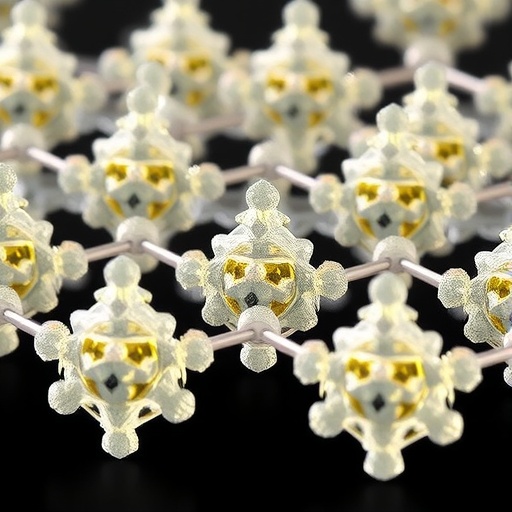The field of nanotechnology has been significantly transformed by the advent of innovative synthesis techniques, particularly in the fabrication of metal oxide nanostructures. Among these, Zinc Oxide (ZnO) signifies a pivotal compound due to its myriad applications ranging from electronics to biomedicine. The recent study titled “Precursor-dependent crystallinity and surface charge modulation of ZnO nanostructures via microwave-assisted synthesis” sheds light on the paramount importance of precursor materials and their consequent influence on the physical and chemical properties of ZnO nanostructures.
At its core, the study examined how different precursors can affect the crystallinity and surface charge of ZnO nanostructures synthesized through microwave-assisted methods. The underlying premise of the research is that the formation and properties of these nanostructures are not merely a product of the synthetic conditions but are also critically dependent on the characteristics of the precursors utilized. By selecting appropriate precursors, researchers can tune the intrinsic properties of ZnO, enhancing its functionality for various applications.
One of the most fascinating aspects of this research is the emphasis on microwave-assisted synthesis, which has emerged as a formidable technique in the preparation of nanomaterials. This method offers several advantages, such as reduced synthesis time and enhanced material uniformity. The authors convincingly argue that this technique can lead to more controlled particle size and morphology than traditional synthesis methods. Microwave radiation facilitates rapid heating, often resulting in more homogeneous crystallization as compared to conventional heating methods.
The research focuses specifically on the crystallinity of ZnO, a vital aspect that determines the material’s electronic properties. Higher crystallinity often correlates with improved electronic properties, such as enhanced charge carrier mobility and reduced defect densities. This study thus aims to explore how manipulating the precursor materials can lead to variations in the crystallinity of ZnO nanostructures. The relationship between the precursor and resulting crystallinity is explored thoroughly, providing insights that could fundamentally alter synthetic approaches in the field.
Surface charge modulation of nanostructures is another crucial parameter analyzed in the study. The surface charge can significantly influence the interaction of ZnO with its environment, affecting its catalytic activity, antibacterial properties, and even its photonic behavior. The researchers meticulously examined how different precursor compositions could lead to desirable surface charge characteristics in the ZnO nanostructures, emphasizing the role of chemical interactions in altering surface properties.
Interestingly, the authors also examined the stability of these nanostructures under different environmental conditions, a critical factor for real-world applications. Stability can often dictate the applicability of nanomaterials in practical settings. By understanding how precursor choice can affect both crystallinity and surface charge, the implications for stability become clearer, enabling developers to select materials that will perform reliably over time.
The results from this investigation not only contribute to the fundamental understanding of ZnO nanostructures but also have compelling implications for their application in photovoltaics, sensors, and photocatalysis. The ability to tailor the properties of ZnO through precursor selection provides a significant leap forward in the ability to engineer materials for specific uses, enhancing their efficacy across various platforms.
The study’s findings provoke exciting discussions regarding the future of nanomaterial synthesis. As the scientists continue to explore the boundaries of microwave-assisted techniques, the potential for innovation in material science grows exponentially. This research marks a step toward more sustainable and efficient synthesis protocols, a goal that resonates strongly within the scientific community amidst growing environmental concerns.
In the spectrum of nanotechnology, where the significance of material properties cannot be overstated, the implications of such research become profound. The potential to manipulate crystallinity and surface charge directly translates to an improved functionality of ZnO nanostructures, which could facilitate advances in technology and industry. Looking ahead, the excitement surrounding the applications of these findings will undoubtedly lead to further research endeavors aimed at unlocking the potential of ZnO in novel domains.
As researchers integrate more cross-disciplinary insights into their studies, we may witness a paradigm shift in how nanostructures are conceptualized, synthesized, and deployed. This newfound understanding of precursor-dependent synthesis, particularly via microwave methods, could be pivotal in realizing the next generation of electronic devices, efficient solar cells, and even groundbreaking therapeutics.
Overall, Boonphan et al.’s investigation provides a comprehensive blueprint for future investigations into nanoscale materials, fostering a deeper understanding of how synthetic choices can drive material performance. The study moves beyond mere observation and sets the groundwork for future research efforts directed at synthesizing nanostructures with tailored properties, highlighting a bright horizon in the world of nanotechnology.
The potential applications stemming from this research not only demonstrate the intricate relationship between synthesis and material properties but also underline the need for continued exploration and innovation in this exciting field. With every incremental advancement, we edge closer to unlocking the expansive capabilities that nanomaterials like ZnO can offer.
As the academic and industrial spheres continue to converge in their efforts to harness the power of nanotechnology, studies like this will serve as guiding lights, illuminating pathways toward novel applications and enhanced material performance. Indeed, the ongoing dialogue surrounding nanostructure synthesis will be critical in shaping the future landscape of technology, healthcare, and beyond.
In conclusion, the synthesis of ZnO nanostructures represents a prominent frontier in material science. The insights gained from understanding precursor-dependent crystallinity and surface charge modulation are foundational for the exploration of next-generation applications. As this research progresses, it is likely to inspire a new wave of innovation, driving the field of nanotechnology toward remarkable breakthroughs and applications that could transform numerous industries.
Subject of Research: Modulation of crystallinity and surface charge in ZnO nanostructures
Article Title: Precursor-dependent crystallinity and surface charge modulation of ZnO nanostructures via microwave-assisted synthesis
Article References:
Boonphan, S., Prachakiew, S., Keereeta, Y. et al. Precursor-dependent crystallinity and surface charge modulation of ZnO nanostructures via microwave-assisted synthesis.Ionics (2025). https://doi.org/10.1007/s11581-025-06660-z
Image Credits: AI Generated
DOI: https://doi.org/10.1007/s11581-025-06660-z
Keywords: ZnO nanostructures, microwave-assisted synthesis, crystallinity, surface charge modulation, precursors, nanotechnology, material science.




